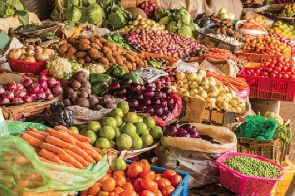Food, which has been the major contributor to the rise in the consumer price index (CPI) in the past months has begun to decelerate in its contribution to the index, recent data from the Ghana Statistical Service (GSS) has revealed.
This affected the year-on-year inflation rate as measured by the CPI for June 2020, which was 11.2 percent, representing a 0.1 percentage points decline from May 2020.
The food and non-alcoholic beverages division recorded an inflation rate of 13.8 percent (y-o-y). This is 1.3 percentage points lower than for May 2020, which was 15.1 percent, but 5.9 percentage points higher than the average over the eight months preceding March 2020 at 7.9 percent.
Within the food division, vegetables at 28.8 percent and fruits and nuts at 17.4 percent were the subclasses with the highest rates of inflation.
The combined CPI measures the change over time in the general price level of goods and services that households acquire for the purpose of consumption.
Although the food division’s contribution has declined, it is still the predominant driver of year-on-year inflation, as it contributed 54.4 percent to inflation (y-o-y), even though it contributed less than the previous two months.
The month-on-month food inflation for June was 0.1 percent, which is less than the overall month-on-month inflation and the month-on-month food inflation in May at 2.3 percent and April 2020 at 6.4 percent.
The non-food inflation was 9.2 percent in June 2020, which is higher than the 8.4 percent measured in May 2020.
Last month, the sub-class in the non-food division with the highest month-on-month inflation was housing, water, electricity and gas at 5.4 percent. This was driven by an increase in rent prices and inflation for refuse collection.
Compared to earlier months, housing, water, electricity and gas also contributed more to year-on-year inflation.
At the regional level, the overall year-on-year inflation ranged from 4.3 percent in the Upper West Region and Volta Region to 15.0 percent in Greater Accra.
According to the Statistical Services, in all, but Greater Accra, Northern Region, and Upper East, Food inflation was higher than Non-Food Inflation.
Click to view details



Business News of Friday, 17 July 2020
Source: goldstreetbusiness.com

















